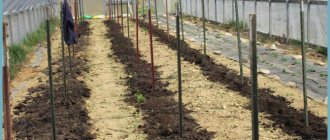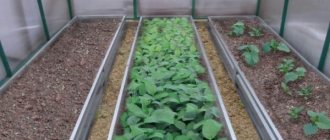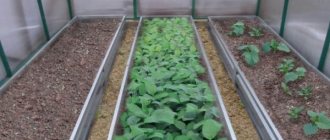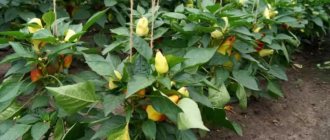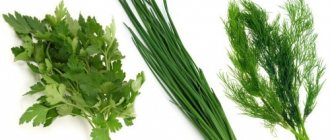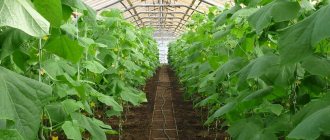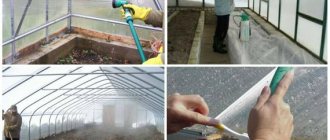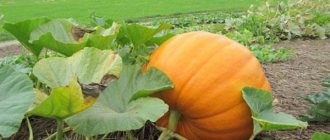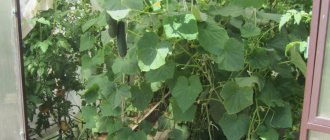Features of growing in greenhouse conditions
Growing cucumbers indoors has its own characteristics:
- the possibility of cultivating long salad cucumbers that are not suitable for open ground;
- carefully monitor the quality of the soil, since in a limited area the amount of nutrients is quickly consumed by plants;
- annual soil replacement or planting catch crops after cucumbers to prevent the development of diseases;
- obtaining a harvest at any time of the year, regardless of the climate;
- with the vertical growing method, the color of the fruit is uniform;
- absence of the likelihood of mechanical damage and the influence of weather conditions on the growing season of cucumbers.
Shaping and pinching
Forming cucumber vines is perhaps the most difficult thing in the entire growing process. So complicated that many greenhouse owners ask experienced neighbors to tear off the necessary leaves, because... They themselves do not immediately remember where everything is, and how to distinguish male flowers from female ones. But, if you take a closer look at our schemes, they will soon invite you too!
In an ordinary film greenhouse, cucumbers are traditionally formed into one stem, where, after gartering, until the growth exceeds half a meter, young side shoots 2-5 cm long and ovaries are removed. This is the so-called “blinding zone”. Further, i.e. higher, up to a level of 1 meter, the side shoots should be pinched above the first leaf - so that only one ovary remains.
At a height of 1.5 to 1.7 meters, pinching must be done above the second leaf so that there are already two ovaries left. Above - pinch out 3-4 leaves and leave 3-4 ovaries. Because There should always be one ovary per leaf. After all this, as soon as shoots begin to appear in the axils of the upper leaves, thin them out so that only two or three remain.
Here are a couple more points:
- Your plant should look like an upside-down Christmas tree - the closer to the bottom, the shorter the side branches.
- The first ovaries in three or four axils need to be torn off. Do not spare them, this way the cucumbers will grow evenly, otherwise the very first fruits will take almost all the strength from the young bush, and it is during this period that it is better to grow roots for a future more solid harvest.
- Basically, 8-12 ovaries are left on the stem, and one or two fruits are left on the side shoots.
Cucumbers with a bouquet type of ovary are formed a little differently:
Tip – it’s easy to make additional cucumber seedlings from plucked cucumber side shoots. To do this, we cut off the upper part of the stepson so that only two leaves remain, after which we put everything in clean water. In a week, white roots will appear that can be planted in the ground.
If you do not monitor the growth of plants, then a real jungle will grow in your greenhouse. And this is shadow and oppression of plants against each other, stem rot, diseases and the harvest is not at the same level. And, in addition to shaping cucumbers, it is also important to know how to tie cucumbers to trellises in a polycarbonate greenhouse:
Necessary equipment
To grow cucumbers indoors, two conditions are important: a suitable greenhouse and its equipment. When choosing a shelter, please note that polycarbonate greenhouses have more advantages than those based on film or frame. They are easy to transport, rearrange and assemble, wear-resistant, have minimal influence of weather conditions, and are more airtight.
The size of the shelter must be at least 10 square meters. m, and the height is about 2 m. It is not recommended to build a higher greenhouse, since maintaining the microclimate in it will be problematic due to the large layer of air. But a lower height when growing cucumbers is also unacceptable. This is due to the fact that cucumber vines, if placed vertically, will not have enough space; their length can exceed 3.5 m.
The choice of location for installing the greenhouse is of great importance. It should be a flat surface or a small hill so that groundwater does not flood it and cause mold to appear.
The greenhouse should be installed in a north-south direction to optimize the receipt of natural sunlight and heat.
Greenhouse preparation
After choosing a location and installing the shelter, preparatory work should be carried out. They consist of the following activities:
- Inspecting the greenhouse for cracks and eliminating them. This will protect the cucumbers from the negative effects of drafts.
- Be sure to treat the inside of the shelter with an antifungal compound to avoid contamination of the soil and seedlings.
- Consider the location of the beds and choose the method of their formation. Most often, longitudinal rows are placed along the shelter. Their width is approximately 50 cm, and the passage must be left at least 90 cm. If the size of the shelter allows, you can use a location method that involves building a shortened bed in the middle with a circular passage and 2 rows along the length of the sides of the greenhouse.
- Cucumbers are a heat-loving crop, so depending on your plans for growing them, you may need to organize a heated floor under the beds to warm the soil when growing cucumbers year-round.
- It is advisable to install containers with water in the shelter, which will perform 2 functions: warming up during the day, giving off heat at night and being a source for irrigation with warm water.
- Provide a ventilation system. These could be additional windows or an automatic ventilation system. Moreover, the location of the vents on the roof and along the walls under the ceiling makes it possible to ventilate the room without drying out the soil, as happens when opening a door and a vent on the opposite wall.
Choosing the right variety
Growing cucumbers indoors means that pollinating insects will not have access to the plant's flower stalks. Therefore, for this case, choose varieties that can self-pollinate or those that do not need pollination at all - parthenocarpic. These properties are indicated on the seed package.
It is important to distinguish cucumber varieties from their hybrids. When planting varietal types of vegetables, their properties will be repeated from year to year, and it is possible to obtain your own seeds from the most successful harvest.
When using hybrids, self-collected cucumber seeds do not carry the properties and qualities of the previous harvest. This means that hybrid seed must be purchased annually.
Let's consider some varieties and hybrids suitable for growing in shelter:
- Adam F1. A hybrid from Holland with the ability to self-pollinate and obtain a rich, early-ripening harvest. The first vegetables can be harvested after 1.5 months, and the fruiting period is quite long. Under favorable conditions, cucumbers are tied in 5-7 pieces. in one node. The fruits are small in size, dark in color with small spines. Suitable for preparation and fresh consumption.
- Herman F1. A wonderful hybrid of Dutch selection. Very early, with a long fruiting period. Small cucumbers develop in bunches of 6-7 pieces. The fruits are juicy and dense. The hybrid is resistant to temperature changes and diseases. Good fresh and canned. Planting in open ground and greenhouses is possible.
- Son-in-law F1. Parthenocarpic hybrid. Fruits develop in nodes of 3-7 pieces. up to 10 cm long. Can be harvested at any stage of maturity. Cucumbers are delicious, yield up to 6 kg per plant. Resistant to powdery mildew and root rot. Adaptable to sudden changes in weather conditions.
In addition to the presented species, it is possible to sow seeds of the following cucumber varieties: “Metelitsa”, “Prestige”, “Ararat”, “Tatyana”, “Fed Papa”, “Everyone is Envy”, etc.
Subtleties of pollination
But the pollination process of varieties and hybrids can be completely different. Let's take a closer look at this process so that you never lose your cucumber harvest in the future.
How do you know what kind of pollination is needed?
To set fruit, self-pollinating varieties, as is already clear from their name, do not need pollen at all. Therefore, only female flowers grow on them, which supply themselves with everything they need:
It is not difficult to visually distinguish a parthenocapric plant from a bee-pollinated one: on the former, the fruit still has a fairly long remnant of the flower, but in bee-pollinated varieties it quickly falls off.
But there are bee-pollinated varieties so tender and rich in yield that it’s a pity to give them up. So is it still worth trying to lure striped workers into the greenhouse so as not to exchange them for another, less tasty variety?
How to attract pollinators?
It's even easier to attract pollinating insects to the greenhouse with fresh pieces of fish sprinkled with sweet water - just hang them under the roof.
Bumblebees can also be attracted for pollination; they also do their job well. To do this, pick flowering onions in the garden, tie them in small bunches and secure them on pegs in the greenhouse between the rows. Also - in front of the open door of the greenhouse and immediately behind it. In just a couple of hours, the bumblebees will begin to fly in. Use honey water carefully for this purpose - ants may appear.
There are also special products on sale for attracting insects, foreign and domestic, with a wide range of effects. It is enough to spray the cucumber flowers with these sprays and open the transoms wide - that’s all.
How to deal with manual pollination of cucumbers?
If the ovaries turn yellow and fall off, it means they remain unfertilized. Of course, there will be no fruits in their place, no matter how sad it is. And all this is due to cold or damp weather, due to which pollinating insects did not reach your greenhouse. Don’t get lost: take an ordinary soft brush for painting (preferably made of natural bristles, or make one from the tip of a cat’s tail), and carefully pollinate the flowers yourself. Otherwise, you will simply lose half the harvest. It makes sense to try, doesn’t it?
Another manual method of pollination is to pick the petals from the male flowers and place them in the female:
You can also pollinate using a cotton swab. Just don’t expect that by hand you can achieve the same result as with natural pollination - not at all. But what if you can’t attract insects? Or does the greenhouse work in winter? Then this is the only way, or give preference to self-pollinating varieties.
There is one more subtlety. If the weather is cloudy during the flowering period, then female flowers will appear several days earlier than male ones. All this will lead to delayed fruit formation, and in some places the flowers may fall off. That’s why some people do this: having figured out where the female seeds are and where the male seeds are, they plant the male seeds in a separate corner of the greenhouse three to four days earlier. When they bloom, they curtain them with film so that the bees don’t take the pollen. If the weather is good, then the female ones will appear any day now, if it is cloudy, then both species will bloom at the same time, because the male seeds were planted earlier. Here's the trick.
Radical method: place a beehive in a greenhouse
If you have a large greenhouse and you grow cucumbers for sale, then solve the problem with pollination once and for all - install a beehive. It can be placed inside, or it can be attached to one of the walls.
Here are some tips on what to look for in this matter:
- If you bought a hive with a family from a beekeeper, ask him to help bring and install it all in a new place. Bees are especially aggressive during transportation, and they do not like the stuffiness - after all, you will close the trays for a while. It is also important to secure the frames correctly to prevent insects from choking. Do all this in the evening, and preferably when it’s cool.
- Place the hive near the south wall of the greenhouse, and open the entrance to the northeast.
- In a couple of days, open three entrances: the front two for summer in the greenhouse, and the back one for the street, behind the other pollen.
- Provide salted water for the bees so that they do not collect it in other non-ecological places.
That's all! From the very first days, the bees hired will begin to carry pollen on greenhouse cucumbers. Believe me, no artificial pollination can replace their careful work.
Soil preparation
For sowing cucumber seeds, it is preferable to use peat pots rather than reusable containers. This is due to the fact that the crop does not like replanting when its root system is disturbed.
Soil for filling seed containers can be purchased in specialized stores and departments. This soil mixture will be disinfected and has a special composition suitable specifically for growing cucumbers.
The second option for obtaining soil for planting seeds is to prepare it yourself. To do this, take the following ingredients and mix them thoroughly:
- turf - 1 part;
- compost - 2 parts;
- peat - 1 part;
- sand - 1 part.
Such a soil mixture should be subjected to a disinfection procedure before use. To do this, you can use one of the options:
- heat it in the oven at a temperature of 170-180 degrees for 20 minutes;
- process in a special steam generator for half an hour;
- dilute 15 ml of Fitosporin in 10 liters of water and pour over the soil.
After processing, it is necessary to add fertilizer to the planting mixture to enrich it with nutrients and elements. For 10 kg of soil add:
- wood ash - 200 g;
- phosphorus fertilizers - 50 g;
- potassium sulphide - 35 g.
After thoroughly mixing the mixture, it must be moistened. High-quality soil is ready for sowing cucumber seeds.
Properly preparing seeds for sowing
Seed material purchased in factory packaging does not require additional preparation. If the seeds are collected independently or purchased in another way, then the following preparatory procedures must be carried out:
- Selection. From the total mass, select the largest and most identical in shape. Prepare a saline solution from 1 tsp. salt and a glass of water. Dip the selected seeds into it. Remove those that remain on the surface. The rest - rinse with clean water and dry until flowability is restored.
- Disinfection. Prepare a slightly pink solution of manganese and dip cucumber seeds in it for 15-20 minutes. You should not make a more concentrated solution or keep the seeds in it for longer than the prescribed time. This will lead to burns of the seed and render it unusable.
Instead of manganese solution, you can use Fitosporin-M or Gamair-SP.
After processing, rinse the seeds with running water and dry.
- Impact of temperature. To speed up germination, place the seeds in a bag and warm them near a heating device. The reverse method is also good - place the seeds in the refrigerator for a day.
- Germination. Line a shallow plate with several layers of gauze. Distribute cucumber seeds over its surface and moisten well. Cover the top with a wet cloth. Make sure that the lower and upper material does not dry out.
Growing seedlings
After selecting the container, preparing the soil and seeds, you can begin directly planting the seed material for seedlings. To do this, follow the work algorithm:
- Place a drainage layer on the bottom of the peat pots and fill 3/4 of the pot with prepared soil on top. Place the container in the tray and moisten.
- Make a hole in the middle of the pot, about 1cm deep, and place a couple of seeds in it. Cover them with soil, slightly compacting it.
- Using a sprayer, moisten the soil surface with water and cover with glass or plastic film.
- Transfer the pots to a sunny windowsill or other place with a temperature range of 25-28 degrees.
Remove glass or film daily, moistening and ventilating the crops. This will prevent mold from appearing on the surface of the soil.
Moisten the soil not by watering, but by spraying water using a spray bottle.
Correct temperature conditions are important for seed germination. Shoots appear after 5-6 days at a temperature of 27-28 degrees. When leaves appear, you should adhere to a daytime temperature of 19-22 °C, and at night - 15-17 °C.
When the first leaf forms on the seedlings, fertilize with a solution of complex fertilizer.
Make sure that the plants do not stretch towards the light source. To do this, rotate the containers periodically. As the plants grow, move them away from each other so that the shadow created does not interfere with their quality development.
How and when to plant cucumber seedlings is described in more detail here.
Watering on schedule
You will be interested to know that the real ancestors of the modern cucumber came from the jungle, and these fruits were very bitter. And all because they grew too crowded, and they ended up lacking either moisture or nutrients. Try to repeat this experiment on your own plot and with ordinary seeds - the result will be the same, believe me. Haven’t you ever bought beautiful, but very bitter cucumbers at the market?
Before flowering, water greenhouse cucumbers once every 5-7 days, and after flowering - every 2-3 days. After all, it is during this period that the fruits begin to “pour,” as people say. Normal watering of cucumbers in a polycarbonate greenhouse is 1-2 buckets per 1 m2. Even if you are very busy, still do not water the cucumbers with cold water - this will cause powdery mildew to appear on the leaves and the plants will die. Just don’t water the cucumbers with a hose - strong pressure will wash away the soil, and this, in turn, will damage the root system.
To prevent the plant from growing too actively upward and taking all the moisture and nutrients, just pinch it:
Preparing soil in a greenhouse
Cucumbers grow well on loose and fertile soil, which retains moisture and is breathable. This is why fruits cannot be obtained on clay or sandy soils. The former are not able to allow the necessary air to pass inside, and the latter soils dry out too quickly, conducting water into deeper layers.
Things to consider:
- If the predecessors of cucumbers in the greenhouse were melons or pumpkins, then it is better to replace the soil with a new one, because it is depleted in nutrition and there is a high probability of common diseases and pests. It is advisable to plant cucumbers after cabbage, carrots, potatoes, onions, and peppers.
- It is necessary to prepare greenhouse beds in the fall. Remove all plant debris and dig up the soil, adding humus or compost 1 bucket per square meter. m. With this option, you can forget about organic fertilizing for 2-3 years, using only mineral fertilizers.
- Another solution to replenish nutrients when digging up beds in the fall is to distribute them per square meter. m of land 2 tbsp. l. superphosphate and 1 tbsp. dolomite flour (can be replaced with wood ash). In the spring, 2 weeks before planting seedlings, add peat, sawdust, humus to the soil, and dig shallowly again.
- To prevent cucumber diseases, be sure to treat the surface of the beds with a solution of copper sulfate. To prepare it, dissolve 1 tbsp in 10 liters of water. l. drug. Consumption rate - 1 liter per 1 sq. m.
- A good solution is to plant green manure in the fall, such as leaf mustard. Before frost, dig up the beds along with the plants. Over the winter they will undergo decomposition, enriching the soil with nutrition and disinfecting it.
An important nuance for growing cucumbers is warming up the soil. If there is a warm base of the beds, seedlings can be planted at any time of the year. If there is no such equipment in the greenhouse, then there are 2 solutions: wait for the soil to naturally warm up or insulate it with organic matter:
- To do this, remove the top soil layer to a depth of 15-20 cm, lay down straw, spread humus and compost on top, and fill the soil layer back.
- Spray the beds with hot water and cover with dark film. As organic matter decomposes, it releases not only nutrients, but also the heat the seedlings need. These events are carried out several days before planting the seedlings.
Selecting cucumber seeds for a greenhouse
Greenhouse varieties of cucumbers differ from those adapted for growing in open ground. Those that tolerate low light levels are selected. The second important issue is pollination. In summer, bees, bumblebees and other flying insects cope well with it in open beds. And in the cold season they have nowhere to come from. It is possible to pollinate plants by hand, but the process is labor-intensive.
The best choice is self-pollinating cucumber seeds for greenhouses:
- Malachite;
- Stella;
- Biryusa;
- Lada.
These are long-fruited hybrids. They tolerate low light well and are suitable for early planting.
Special greenhouse varieties of cucumbers have been developed for cultivation in the conditions of Siberia and central Russia. This:
- Brawler;
- Ant;
- Murashko;
- Bidretta;
- Twixie;
- Hallie.
Popular for spring planting are:
- Elegant;
- VIR 516;
- Altai early 166.
The varieties are highly resistant to lack of light and moisture:
- Marfinsky;
- Russian;
- Home;
- Relay race;
- Rykovsky;
- Regatta;
- Willow;
- NK-mini.
Gribovsky 2 and Maysky are also considered the best varieties of cucumbers for greenhouses. They bear fruit 50 days after the seeds germinate.
2-3 year old seeds have the best germination. Before planting, they are calibrated, removing empty and diseased ones. To disinfect seeds, an aqueous solution is prepared from boric acid, copper sulfate and nitrophosphate. Aloe juice is also suitable for this purpose. The seeds are placed on a cloth moistened with the solution and left for 12 hours. After this, they are washed under running water, laid out on damp gauze and placed in the refrigerator for a week to harden. Hardening temperature – 0 °C. The gauze is periodically moistened.
Transplanting
In greenhouses, without additional heating, plant seedlings no earlier than the end of May, when the soil temperature inside reaches 14-16 degrees, so that the weak roots do not freeze, but can adapt to new conditions. To measure the level of soil warming, lower the thermometer into the soil to a depth of 20 cm for 30 minutes in the morning.
Cucumbers can be planted in heated shelters as soon as 4 leaves have formed on the seedlings. This occurs approximately 35 days after sowing the seeds.
The most commonly used scheme for planting cucumbers in a greenhouse is:
- two rows of cucumbers are placed in a longitudinal bed;
- the distance between neighboring bushes in a row is maintained at 30-40 cm;
- seedlings in one bed, but in adjacent rows are planted in a parallel or staggered order, keeping a distance between them of at least 50 cm;
- the hole should be strictly under the trellis, or stretch a cucumber net between the rows.
Algorithm for planting seedlings in a greenhouse:
- Moisten the soil in the beds with hot water.
- Make holes and distribute peat pots with seedlings over them. The recess should be such that the upper edge of the container protrudes above the surface of the ground. Lightly compact the soil.
- Sprinkle a 2-centimeter layer of peat with sawdust on top, mulching the root part of the plants.
- Do not water the planted seedlings for 2 days.
Watch a video about planting cucumber seedlings in a greenhouse:
Planting scheme
If planted too closely in a greenhouse, mature plants will subsequently interfere with each other, leading to a lack of light and an increased risk of fungal diseases. To avoid this, it is necessary to plant cucumbers according to a certain pattern.
Plants can be placed in 1 or 2 rows.
- When planting in two rows, seedlings are planted in a checkerboard pattern. The distance in one row between cucumbers depends on the selected variety and can range from 45 to 60 cm.
- For single-row placement, the distance between rows should be 80 cm, and for double-row placement, 1 m between two pairs of rows (within a pair, rows are spaced at intervals of 55 cm).
Optimal conditions for the growth of cucumbers
For high-quality growing season of cucumbers, it is necessary to create and maintain a microclimate with certain conditions, as well as carry out agrotechnical work in a timely manner.
Watering
Cucumbers need regular watering of the beds, but make sure they do not become waterlogged. Warm the water for the procedure in the sun or take it from containers located inside the greenhouse. If you water with cold water, the crop will become infected with rot and spots.
If the temperature of the irrigation water is too low, a narrowing of the middle part is noticed on the fruits, and the cucumbers become deformed.
After watering, loosen the soil to prevent the formation of a crust on the surface. It will become an obstacle to the path of air to the root system and will serve to more quickly lower moisture into the lower soil layers. This procedure will also help cover the roots washed out as a result of moisture with soil. Mulching helps to retain moisture in the beds for a long time.
Sprinkling is very important for the crop. It consists of generously spraying the green part of the plant with water. Thus, the liquid flows slowly to the root system, allowing the cucumbers to better saturate themselves with moisture. In addition, the humidity inside the greenhouse increases, which has a beneficial effect on the plants.
Feeding
Be especially careful when fertilizing the soil in a greenhouse, since the formation of ovaries and the ripening of fruits directly depends on this. Keep in mind that an excess of mineral components in the soil is just as undesirable as their deficiency. Calculate the total volume of fertilizer applied per season, including limiting substances and mineral supplements. The number of procedures for adding nutrition to the soil for cucumbers should not exceed 5.
With a lack of nitrogen on the fruit, a narrowing of the tip and a change in its color to yellow are noticeable. If there is a deficiency of potassium in the soil, pear-shaped cucumbers are formed.
Cucumbers respond especially well to the addition of infusions of chicken manure, humus and mullein. To prepare food, mix 150-200 g of organic matter and 10 liters of water. Leave in a warm place to ferment for 2-3 days, stirring the mixture occasionally. Add 30 g of superphosphate. The distribution rate of the infusion is 1 liter per 1 sq. m of beds or for 4-5 plants.
During flowering, add 30 g of potassium salt to this infusion.
The amount of mineral nutrition per 10 liters of water (per 1 sq. m) in different phases of cucumber growth is slightly different:
- before fruiting: ammonium nitrate - 5-10 g;
- superphosphate - 20 g;
- potash fertilizers - 10 g.
- ammonium nitrate - 20-25 g;
Fertilizers can be applied by root and foliar methods. It is advisable to carry them out in the evening or in cloudy weather.
Light mode
A 10-hour daylight hours is sufficient for the growth and development of cucumbers. When the amount of light decreases, the growth rate decreases significantly. Therefore, in the absence of sunlight, due to weather conditions, it is impossible to do without the use of phytolamps or other sources of artificial lighting.
Temperature
Cucumbers are very dependent on the temperature in the greenhouse. So, in different phases of growth it is necessary to maintain different levels of heat:
- planting seedlings - 20-22 degrees;
- flowering - 25-28 degrees;
- fruiting - 25-30 degrees.
At temperatures from 17 to 19 degrees and from 35 to 40 degrees, the formation of ovaries does not occur.
Critical temperatures for cucumbers:
- growth cessation - 15 degrees;
- cessation of growth - 10 degrees;
- death - 7-8 degrees.
Humidity
Cucumbers are very demanding on the level of air humidity, so it should be maintained between 90 and 95%. When this indicator decreases, the ovaries stop forming and the cucumbers slow down their development.
Ventilation
The ventilation procedure is necessary to prevent the spread of diseases, especially rot, which develop in a humid, warm environment. In addition, this provides additional access to clean air into the greenhouse. Ventilation helps reduce the air temperature on hot days to the required level.
Bush formation
Shaping helps to avoid bush thickening and optimize its productive qualities. Cucumber plantings become not only beautiful, but also evenly illuminated by the sun, accessible for aeration, and convenient for various agricultural work. This procedure involves pinching the shoots and tying them with the further direction of the head lash.
It is important to remember that all manipulations to form a cucumber bush are carried out strictly before the onset of the flowering period. When the first flowers appear, any work related to moving the lashes is prohibited.
The need to form a bush is explained by the following arguments:
- If there is excessive branching, the root system cannot cope with saturating the entire plant. As a result, the fruits become deformed and their taste deteriorates.
- Dense vegetation does not allow air to penetrate through the greenery. This negatively affects fruiting and creates a favorable environment for pathogens of various diseases.
- Weeding, loosening, spraying and watering are more convenient when cucumber bushes are formed.
Pinching (pinching)
Pinching helps reduce leaf mass for a more active and longer fruiting period. Removing canes with male flowers that do not bear fruit stimulates the development of female fruiting inflorescences. The quantity of harvest and its quality increases.
To perform the procedure correctly, you need to be able to distinguish male and female flowers from each other:
- female inflorescences are formed in pairs, and barren flowers are formed in 6 pieces;
- the stem of the female flower is longer than that of the male;
- ovaries are present only on female inflorescences.
Pinching is not carried out only on specially bred hybrids that have a single-wattle development or do not produce an excessive amount of barren flowers.
For self-pollinating varieties, leave enough male flowers so that their number with female ones is approximately equal. For parthenocarpic varieties, the presence of male inflorescences is not required.
The pinching procedure after tying cucumbers goes like this:
- When forming the 5th leaf, all shoots and tendrils located below it are removed.
- When 7-8 leaves appear, a pair of shoots are left from the central stem.
- After the 11th leaf, the tips of the shoots are pinched, provoking their peripheral development and ovaries. On each shoot, 3 leaves and 3 ovaries are left.
- Parthenocarpic varieties are formed, leaving one stem. When it grows to 50 cm, the tendrils, flowers and branches are removed, and the lateral shoots are pinched down to 1 leaf.
Pinching forms the bush in the form of an inverted pyramid.
Tying up
Tying cucumbers is done to:
- the lashes did not interlock with each other using whiskers;
- the process of plant care and harvesting was simplified;
- the bush had enough sunlight for the entire plant part.
These measures make it possible to horizontally grow cucumbers and form a bush. Mechanical damage to vines and fruits and their rotting on the ground are prevented. You should start tying when the seedlings in the greenhouse grow to 30-40 cm. At this time, the vine is still flexible and does not break when its position changes.
To carry out garter work you will need:
- wooden or iron supports;
- strong, taut wire;
- trellis net for cucumbers;
- garters made of long strips of cotton or nylon fabric about 3 cm wide.
You should not use thin laces or wire to tie cucumbers, as they will pinch the stem as they grow. Disinfect all garter material by boiling or bleach before use.
You can purchase special plastic garters. Their clamping is adjustable with notches and can be used repeatedly.
Caring for cucumber seedlings
The main aspects of caring for cucumbers are maintaining temperature, daylight hours and watering. When the sprouts begin to hatch, the box is moved to the warmest and brightest place. It is necessary to provide light for 10 hours. This may require phytolamps. The temperature changes according to the following schedule:
- before emergence, 25–27 degrees;
- during germination of the first seedlings, 21–23 degrees;
- with mass germination, up to 24 degrees during the day, and up to 19 degrees at night.
Watering is carried out no more than 2 times a week. The indicator is the top layer of soil. As it dries, it is necessary to moisten the soil with settled water at room temperature. Do not water with boiled water. It no longer contains any useful elements.
The procedure for picking cucumber seedlings will not be superfluous. This is especially necessary if seedlings grow in common containers. For this, individual cups are prepared. A pre-watered sprout is carefully removed with a lump of earth and replanted. This manipulation is carried out when the seedling is 6–8 days from germination.
Diseases and pests
It is reckless to assume that closed soil protects cucumber plantings from pests and various diseases. This means you need to know what dangers threaten the harvest and how to deal with them. The following diseases are common:
- White rot. A fungal disease characterized by the presence of a light, almost white, coating not only on the fruit, but also over the entire surface of the bush. It spreads quickly, destroying plants. The fungus persists in the soil. Control measures involve destroying affected plants and changing the soil.
- Gray rot. Identified by slippery gray spots on the surface of fruits, flowers and ovaries. At the first stage of infection, spraying with a solution of copper sulfate 1 tsp is carried out. and 1 tbsp. ash per 5 liters of water. The drug "Barrier" is effective. When the disease is in an advanced state, only radical methods can help.
- Root rot. Drying leaves, changing the color of the plant, and the appearance of cracks on the stems are all signs of infection. Rot can be caused by planting seedlings too deeply, excessive watering, or cold water when moistening. Sprinkle the areas affected by the fungus with crushed chalk or wood ash and dry. Do not allow moisture to enter the plant when watering. Dead plants are destroyed by fire, and soil is removed from the holes by spilling a solution of manganese or copper sulfate. Afterwards, the hole is filled with new soil.
- Powdery mildew. It is characterized by the appearance of a white coating, first on the leaves of cucumbers, and then on the stems. The fungus actively spreads in warm and humid conditions, so if it is detected, treat the cucumbers as soon as possible. The preparations “Topaz” and “Zaslon” have an effect against powdery mildew. Their use when preparing the solution must be in accordance with the instructions.
- Downy mildew. It is determined by the appearance of spots on the leaves of cucumbers that resemble burns. In a couple of days the sheet dries completely. To stop the spread of the disease and destroy it, spray with Quadris (5 g per 10 liters of water). You should stop watering and ventilate the greenhouse more often, avoiding excessive air humidity.
- Brown spot. When infected, fruits develop wine-brown spots oozing from the inside. Then the rot spreads to the entire plant. Spots of the same color are seen on leaves and stems. Within a week the plants die. Control measures come down to the destruction of diseased plants and reducing the level of soil and air moisture in the greenhouse.
- Black mold. Manifestations of the fungus are noted in the appearance of spots on the leaves, which over time merge into one and become covered with black spider mold. Preventive measures include the use of treated seeds and disinfection of the soil and premises.
In addition to diseases, insect pests can attack the greenhouse crop. Some of the most common are:
- Melon aphid. The negative impact of aphids is manifested in twisting and wrinkling of leaves on the vines. If you turn them over, you will notice a cluster of small insects on the underside of the leaf blade. They feed on plant sap, which leads to a lack of nutrients, stunting of development and drying out of the crop. In small areas, it is recommended to use traditional methods of control against aphids. This can be an infusion of onion peels or an ash solution with laundry soap. Large greenhouse farms use chemicals.
- Greenhouse spider mite. It is difficult to detect due to its small size, but cobwebs on the plant are a sign of the presence of a mite.
The appearance of insects is associated with the presence of weeds in the greenhouse and conditions suitable for the parasite. It is recommended to fight it only using chemicals, so as not to waste valuable time. The following drugs can be used: “Plant-pin”, “Aktellik”, “Fitoverm”, etc. They must be processed strictly in accordance with the instructions for the drug.
How to determine that cucumbers need feeding
The issue of feeding plants in a greenhouse is very relevant. The fact is that the exact mineral composition of the soil can only be determined through expensive research. But experienced gardeners know how to detect a deficiency or excess of substances in greenhouse soil by the appearance of the plant. Nitrogen. An excess of this mineral leads to fattening of the bushes: all the growth of cucumbers goes into succulent leaves and stems, but flowering and fruiting are delayed. By the way, the same “behavior” of the crop can be noticed when overfeeding with fresh manure. On the contrary, if the leaves and stems are too light, grow very slowly and die quickly, the fruits are too small - this is a symptom of a lack of nitrogen in the soil.
Symptoms of nitrogen deficiency
Phosphorus. If a plant lacks phosphorus, its leaves become very small and acquire a rich green color (even with a blue tint); when the shoots dry out, they turn black. Culture growth is slowing down. However, it should be noted that the symptoms of excess moisture or lack of oxygen can be the same. Keep in mind that phosphorus starvation in plants in our latitudes is rare.
Potassium deficiency symptom
Potassium. If cucumbers lack this chemical element, then you will notice browning and drying of the lower leaves of the bush. In addition, the fruits acquire an irregular hook-shaped shape. However, if the fruits are deformed, but the leaves of the plant are fine, then the problem is not a lack of potassium, but that the bushes were not completely pollinated.
Attention! If you notice symptoms of a lack of minerals in plants, immediately feed the bushes.
Carefully monitor the plants, especially at the initial stage of their growth - after transplanting the seedlings into greenhouse soil. This way you can prevent the development of diseases and ensure a good harvest.
Problems and their solutions
It happens that infection with diseases is excluded, but some problems still arise on the plantation. Let's look at some of them.
No ovaries
Reasons for the problem of ovary formation on cucumbers:
- insufficient ventilation;
- deficiency of minerals in the soil;
- impossibility of pollination (on pollinated varieties);
- unfavorable temperature conditions, or microclimate in general.
The lower branches dry out
Such manifestations are possible for several reasons:
- scorching sun rays;
- contact with leaves of mineral root fertilizers;
- waterlogging or moisture deficiency in the soil;
- deficiency or surplus of nutrients;
- lack of light and air.
Fruits grow slowly
Slow fruit growth is due to:
- low-quality seed material;
- failure to comply with the deadlines for planting seeds or planting seedlings;
- microclimatic disturbances;
- lack or excess of nutrition;
- dense planting without bush formation.
Cucumbers are bitter
A bitter taste (exceeding the cucurbitacin level) in cucumbers can be observed due to plant stress for several reasons:
- too bright scorching sun rays;
- sudden changes in temperature;
- violations of the temperature regime necessary for fruiting;
- lack of nitrogen and phosphorus in the soil;
- interruptions in watering or cold water;
- plants interfere with each other due to their close proximity.
Growing cucumbers in greenhouse conditions is not easy. The quality of the harvest and its quantity depends on many factors that need to be considered from the preparation stage to the fruit harvesting stage. By following all agricultural techniques and creating the necessary conditions for the crop, you will enjoy growing, and cucumbers will delight you with fragrant fruits for a long time at any time of the year.
0
0
Copy link
Proper feeding
In total, greenhouse cucumbers will need to be fed 5-6 times over the summer:
- The first feeding is before flowering: dilute 2 tablespoons of Agricola Forward per 10 liters of water.
- Do the second at the beginning of flowering: dilute 1 teaspoon of urea, potassium sulfate and 2 tablespoons of Effekton-O fertilizer in 10 liters of water.
- Feed the cucumbers four more times during fruiting. For the first time, dilute 2 tablespoons of Agricola Vegeta and 1 tablespoon of Agricola for Cucumbers in 10 liters of water, and water 5 liters per square meter. After 7-8 days, repeat feeding, diluting 2 tablespoons of Rossa fertilizer with the same amount of water, and watering in the same doses as before. And after another 8 days we carry out the third feeding: 2 tablespoons of “Ross” and one “Agricola-5” per 10 liters of water, the dosage is the same.
Pay attention to these warning signs. If the leaves grow slowly due to a lack of nitrogen, they are small in size, turn yellow too early and fall off. But if the flowers fall off even during the ovary period, there is clearly a lack of phosphorus compounds, or it is simply due to the lack of light. Even with a lack of phosphorus, the leaves become smaller and become dark green. Plant growth also slows down.
